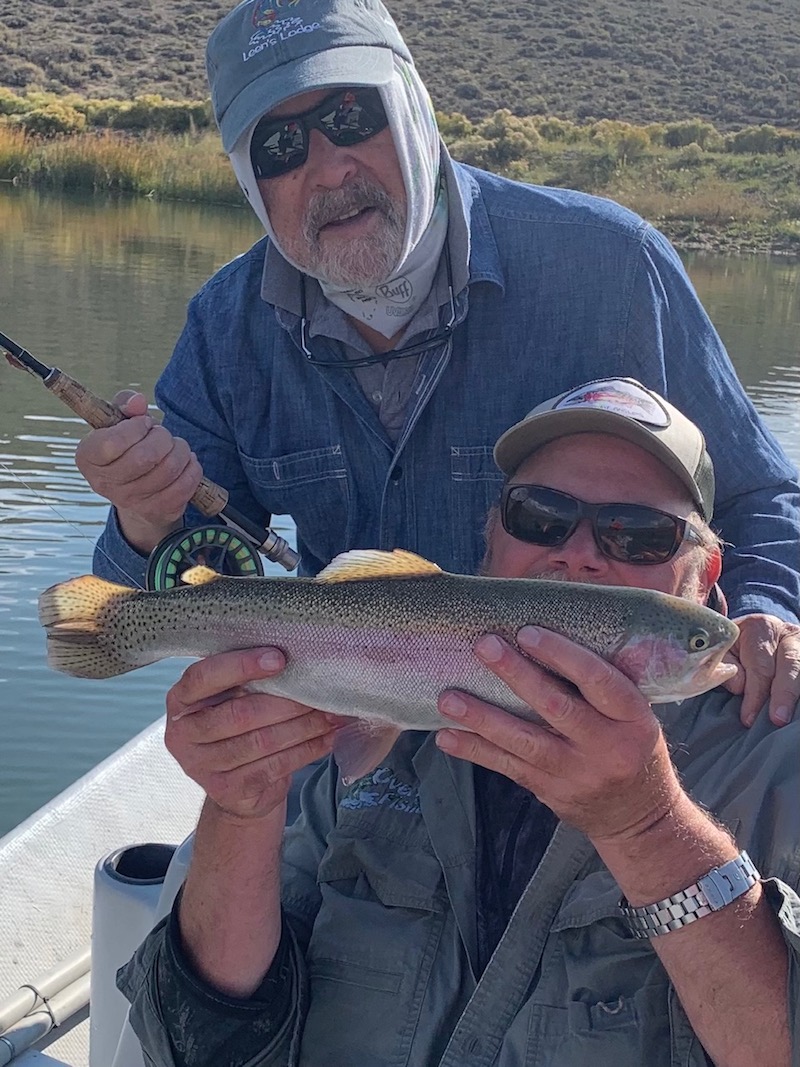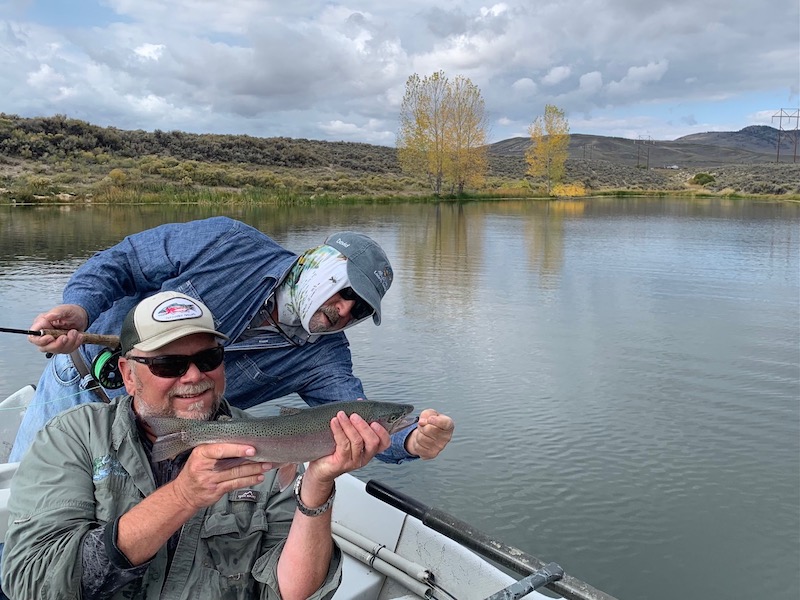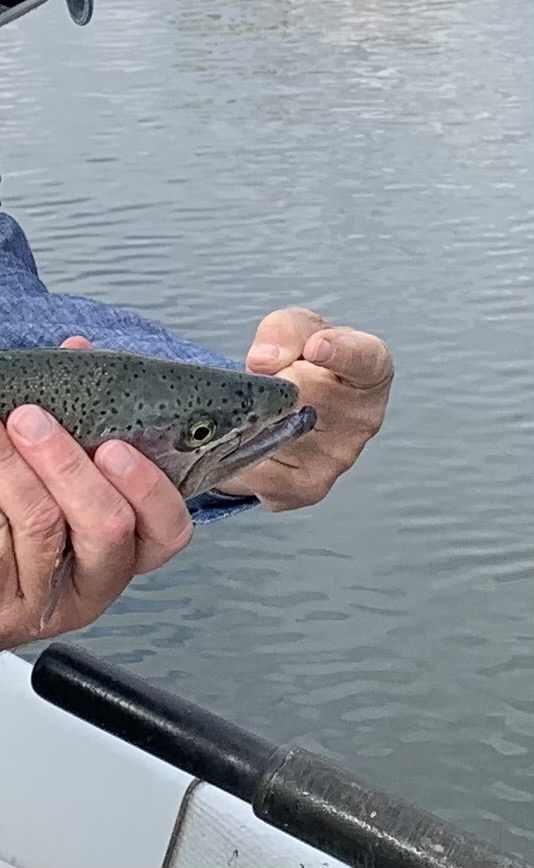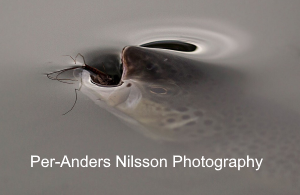The winter snows around Hidden Valley Ranch pond start their melt and runoff in March when seasonal warming from the longer sunny days replaces the short, dark, cold days of winter. March is when female rainbow trout find gravelly shallow spots and build their "nests" to hold hundreds and even thousands of eggs. When the male deposits sperm over the eggs and they are fertilized, the female uses her tail to move the displaced gravel back over the nest and cover the eggs. In four to seven weeks, hatchings emerge. They consume their yolks for about two weeks, and then the rest of their life cycle begins.
Before leaving Colorado in October, we met two of those former hatchlings who started their journey about four and a half years ago.
This pond is about 15 miles from Kremmling, CO. It is on private land, accommodates only one fishing boat at a time, and offers "catch and release" fishing in a protected and well-cared-for environment. Jared Hawn, an experienced guide and quintessential Coloradan, arranged the trip.
Rainbow trout hatchlings are eaten mostly by larger fish, and few make it through the first year. They start out eating zooplankton and graduate to consuming other small fish, fish eggs, insect larvae, some crustaceans, and a variety of insects. Trout love insects.
As they grow larger, rainbow trout need to learn about eagles and other birds of prey, raccoons, herons, and fishermen. The last on that list are the unnatural predators. Trout don't have instincts for them but do become aware of an unnatural yellow dry-fly fishing line that lands on the surface of the pond. The shadow of a boat can also spook them. Trout know what insects are naturally present at any given time, which is why a fly fisher tries to "match the hatch."
It was the end of summer and my third trip to the pond. The drive had taken about an hour. July's midday 70s had given way to brisk 60s and early morning 40s, so lots of layers were needed.
Jared rigged a "hopper and double dropper" combination. In this configuration the imitation grasshopper serves as a floating dry fly and also as a strike indicator. It is unusual to have a fish actually take the hopper because it is late in the season and there aren't many grasshoppers still around. That is changing, though. Global warming is extending the summer in Colorado. Aspen yellow is coming later to the trees, as you will see in one of the photos. So a few hoppers were still kicked up as we walked through the grass at the edge of the pond.
Below the hopper by about three feet, we tied on a leech imitation with a gold bead head. Rainbow trout like the leeches in this pond and are fooled by the small gold-colored covering on the "head" of the fly. This leech imitation is a sinking, or "wet," fly. We tied it on with a special knot and attached the end of the tippet (small line) to the hook of the hopper. We then added a third and very small nymph imitation using the same technique. The rig now had three flies, two wet, in a sequence from larger to smaller, and the hopper.
A word is needed about tippets. There are various sizes, which are numbered - the bigger the number, the smaller the size. A smaller tippet is needed for two reasons. First, when the wet flies are tiny, the eye of the hook can accommodate only a very thin line. Second, it is harder for a trout to see a tiny line. So, we used a 3x leader size to tie on the hopper and a 4x (smaller) to tie the leech to the hopper and a 6x (tiny) to tie the nymph to the leech.
Now the trick was to cast this rig, not get tangled, and have the line "lay out" or unfold so as to look natural and not spook the trout. Remember the warning about trout and their reaction to shadows like the one from the boat. A cast of about 40 to 50 feet would be long enough to clear the shadows. Jared deftly parked the boat over a weed bed and anchored. The target for the cast was beyond the weed bed in the deeper water but in the direction of the shoreline. That location would make the hopper appear more natural, since a grasshopper is not normally found in the middle of a lake but can be kicked up from the grass along the pond's edge.
It was a magnificent day. The sun got warm enough. The wind was down. The pond was magical. The Colorado scenery was simply splendiferous. And I was about to meet two survivors of that Rainbow spawn four years earlier.
Here's the female, with Jared holding her.

Here's the male. The pond was very flat for a brief period, so the yellow reflection from the Aspens enhances the view.

My finger is pointing at male's kype. As male rainbows mature, their front tooth space grows into a hardened extension of the lip. That is the fighting tool they use to keep other males away while they are defending the nest of eggs over which they are trying to deposit their sperm.
Here's a blowup of the kype.

On this remarkable late-season day, two mature rainbows took a nymph or a leech and allowed me the experience of handling one with a kype and one without. Will they be a pair that produces hatchlings in the feeder stream next March or April?
Rainbows and most of the entire salmon family return to spawn at the place of their birth. This pond is no different.
With luck, I hope to return and greet them again.
In closing we offer a photo of a trout about to eat a mayfly. Note that the water tension hasn't broken yet, and this extraordinary photo captured the exact moment before it did.
(See photo here: https://www.facebook.com/perandersnilssonphotography/photos/pb.100063493990716.-2207520000./511881349196763/)

(Photo credit: Per-Anders Nilsson)
Tight lines
David R. Kotok
Chairman and Chief Investment Officer
Email | Bio
Links to other websites or electronic media controlled or offered by Third-Parties (non-affiliates of Cumberland Advisors) are provided only as a reference and courtesy to our users. Cumberland Advisors has no control over such websites, does not recommend or endorse any opinions, ideas, products, information, or content of such sites, and makes no warranties as to the accuracy, completeness, reliability or suitability of their content. Cumberland Advisors hereby disclaims liability for any information, materials, products or services posted or offered at any of the Third-Party websites. The Third-Party may have a privacy and/or security policy different from that of Cumberland Advisors. Therefore, please refer to the specific privacy and security policies of the Third-Party when accessing their websites.
Cumberland Advisors Market Commentaries offer insights and analysis on upcoming, important economic issues that potentially impact global financial markets. Our team shares their thinking on global economic developments, market news and other factors that often influence investment opportunities and strategies.

